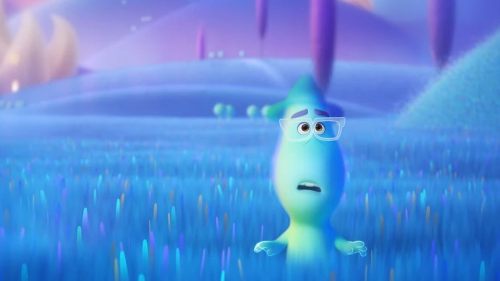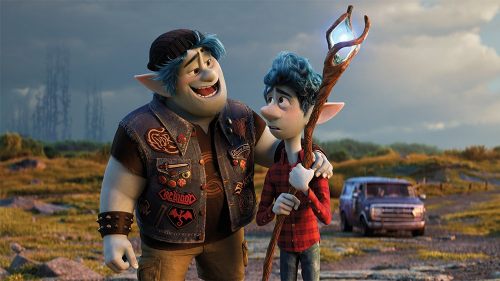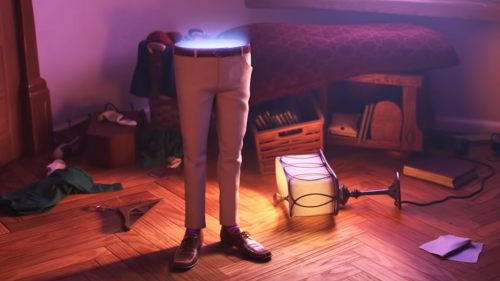A First-Hand Look Inside Pixar’s COCO
It only took our group of jet-lagged journalists thirty seconds to be overcome with child-like wonder after setting foot on Pixar’s campus. It looks like a college campus, employees riding their bikes between buildings and chatting outside. The whole place has that starry-eyed sheen you’d expect places like Google to have, happy and high-achieving. In the courtyard outside the Steve Jobs Building in the center of campus stands a huge sculpture of Pixar’s famous toy ball, next to an enormous version of the lamp from the credits (which, to our delight, turns on every night).
There’s art throughout the entire campus, too, from concept art to statues of characters from the films, from The Incredibles to Bing Bong from Inside Out. All of the décor in the Steve Jobs Building is Coco-themed now, colorful banners made to look like papel picado hanging around the edges of the atrium.
The time at Pixar was a whirlwind of presentations and footage, and by the end of it, one realization kept coming back to me: I had no idea how much it took to make an animated movie. I had a very cursory knowledge of animation (read: almost nothing), and I’d sat through the wave of names during a movie’s end credits, but putting faces to each of these people was a completely different experience.
There’s someone who coordinates the way that clothing falls on different characters, even (or especially) the skeletons (Emron Grover); there’s someone who wrangles every single light source you see in the background of every single scene (Danielle Feinberg); there’s someone who decides how many wrinkles to put on the neck of the ugly-but-cute Xolo dog, Dante, and figures out how they should move (Christian Hoffman and the character team).
Director Lee Unkrich pitched a movie centered around Día de Muertos (along with two other pitches, as is Pixar custom) back in 2011, starting a series of research trips to Oaxaca soon after. Daniel Arriaga, the character art director, told us they started work on trying to animate skeletons in 2012. Since Pixar had never animated skeletons before, they had to go through a full process from character design, deciding which parts of the skeletons were moveable and which were static, and totally redesigning a program to make sure that the clothing sat correctly on each of the characters in the Land of the Dead.
All that to say, the journey from script to finished film is a long and detailed one that includes storyboarding, voice acting, creating physical and then digital character models, fleshing out an entire world and lighting it, texturing each character, and creating music to tie everything together. All of these aspects have to be equally strong, and the fact that Pixar places as much emphasis on story development as it does on the animation itself is the reason they continue to be as iconic and well-loved as they have been for decades.
And even though each of these pieces is necessary and fixed, having to work together in tandem, Pixar’s culture makes sure that the system doesn’t become rigid or rote during a film’s creation. Every twelve weeks, Pixar holds an internal screening of the film they’re working on in order to course correct and make story changes.
Even our day itself mimicked this perfect balance of technical and creative precision; not only did we see presentations on all of these different aspects of animation, but we got the chance to eat Mexican food and end our day in one of the art studios. Alonso Martinez, a character animator, chatted with us as we painted 3-D printed versions of Coco’s alebrije, Pepita, a spirit creature based on the folkloric Mexican creatures invented by Pedro Linares. In the film, alebrijes populate the Land of the Dead, but the imaginary creatures aren’t actually linked to Día de Muertos. Alonso brought in his personal collection of alebrijes to inspire us. It was nice to zoom back in on the micro-level of the heart of Pixar after seeing the entire creative universe: talking to a single animator about his passions, his plans to bring his mom to the premiere, and how he got started at Pixar as we tried our hands at our own artistic endeavor.
And this was really the most rewarding part of the trip; everyone working on Coco is (obviously) insanely talented, but they’re also so passionate about what they get to create together. You can see it in their faces as they talk about the film. Gini Santos, a supervising animator, lit up as she showed us examples of different skeletons’ gaits; Danielle Feinberg grinned as she showed us examples of upping the neon in the lighting, and co-director Adrian Molina spoke from the heart about the beauty of being able to depict a Mexican family onscreen.
Heart is the glue that’s always held Pixar films together – so it was no surprise that the people behind these movies care as much as they do.



